Site pages
Current course
Participants
General
Module 1: Introduction and Concept of Soil Erosion
Module 2: Water Erosion and Control
Module 3: Wind Erosion, Estimation and Control
Module 4: Soil Loss- Sediment Yield Estimation
Module 5: Sedimentation
Module 6: Topographic Survey and Contour Maps
Module 7: Land Use Capability Classification
Module 8: Grassed Waterways
Module 9: Water Harvesting
Module 10: Water Quality and Pollution
Module 11: Watershed Modeling
Keywords
Lesson 12 Stream Bank Erosion
12.1 Introduction
Rivers and streams are products of their catchments. They are often referred to as dynamic systems which mean they are in a constant state of change. The factors controlling river and stream formation are complex and interrelated. These factors include the amount and rate of supply of water and sediment into stream systems, catchment geology and the type and extent of vegetation in the catchment. As these factors change over time, river systems respond by altering their shape, form and/or location. In stable streams the rate of these changes is generally slow and imperceptible.
Erosion is the removal of soil particles from a site due to the forces of water, wind and ice. Over time, these forces slowly wear away or disintegrate the soil. In case of a stream, erosion may occur in several ways and may be identified as given below.
Erosion of streams in agricultural areas normally occurs as a result of one of the three factors:
Change in stream flow,
Water flowing over or through the stream bank and
Discharge of concentrated runoff from other sources.
Streams are generally subject to wide fluctuations in both flow depth and velocity over a period of years due to normal seasonal changes in rainfall and large single-storm events. As the flow depths and velocities increase, the force of the water flowing against the stream bank removes soil particles from the banks, and in many cases erosion causes banks to slump and fall into the flowing water. A typical stream bank erosion is shown in Fig. 12.1. In extreme situations where high flows persist over long periods, banks may erode several feet annually. Rain falling on stream banks or runoff from adjacent fields that enters a stream by flowing over the stream banks can also erode soil from the banks, particularly if banks are inadequately protected. Finally, water discharged into a stream from tributary drainage systems (such as waterways or tile lines) can also erode stream banks, particularly if the water is discharged in an area where the bank is unstable and highly erodible. In many cases, moving the outlet to a point where the steam is less erodible or stabilizing the outlet area with rock can alleviate this problem.
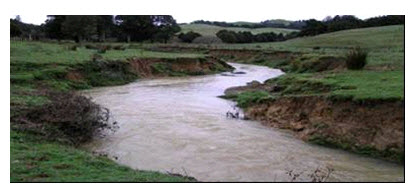
Fig. 12.1. Stream Bank Erosion Showing Slump and Meandering. (Source: www.teara.govt.nz)
Although a stream channel may appear to be stable, when viewed over a period of decades or centuries, most streams exhibit a tendency to adjust or shift location. In some instances, changes result from single event, such as a tree falling into a stream and deflecting the flow of the water. In other instances, these changes are due to differences in soil type and structure within the stream channel or are the result of erosion occurring from catastrophic storm events. Any straight stream channel will eventually erode some portions of each bank and begin to bend or meander. As the stream bends become longer and more sharply curved, more soil is eroded from one side of the channel and deposited on the other side of the channel.
12.2 Susceptible Area to Stream Bank Erosion
Catchments with little vegetation cover and steep gradients will often have high rates of water runoff that result in high-velocity stream flows. Stream straightening, dredging or realignment to accommodate roads or rail lines lead to increased stream impact and velocity, which in turn increase the energy applied to stream banks. The erosive impact of these high-velocity stream flows depends on the stability of the bank material. For instance, sand will erode more easily than gravel and silt will erode more easily than sand.
12.3 Process of Stream Bank Erosion
Erosion of stream or river banks through lateral (side) erosion and collapse often causes high sediment loads in creeks and rivers. The problem is often initiated by heavy rainfall in catchments with poor vegetation cover, causing excess runoff. The resultant high volume and velocity runoff will concentrate in the lower drainage lines or streams within the catchments. When the stress applied by these stream flows exceeds the resistance of the local soil material, stream bank erosion occurs. As the sediment load increases, fast-flowing streams grind and excavate their banks in the lower landscape. Later, the stream becomes overloaded or velocity is reduced and deposition of sediment takes place further downstream or finally in dams and reservoirs. Stream bank erosion is exacerbated by the lack of riparian zone vegetation and by direct stock access to streams.
The mechanisms of stream bank erosion can be classified into two main groups:
Bank scour and
Mass failure
In most of the cases bank instability can occur due to either scouring or mass failure being dominant. Bank scour is the direct removal of bank materials by the physical action of flowing water and is often dominant in smaller streams and the upper reaches of larger streams and rivers. Mass failure, which includes bank collapse and slumping, is where large chunks of bank material become unstable and topple into the stream or river in a single event. Mass failure is usually dominant in the lower reaches of large streams and often occurs in association with scouring of the lower banks. By looking carefully at the processes operating at a site it may be possible to narrow down the probable causes of instability.
12.4 Bank Scour
Bank scour is the direct removal of bank materials by the physical action of flowing water and the sediment it carries. Undercutting of the stream bank toe due to flowing water causing bank scour is shown in Fig. 12.2.

Fig. 12.2. Undercutting of the bank toe, a sign of bank scour. (Source: http://www.derm.qld.gov.au/factsheets/pdf/river/r2.pdf)
As flow velocity increases, the erosive power of flowing water also increases and scour may occur. Increases in flow velocity can be the result of natural and/or human induced processes. Undercutting of the bank toe is an obvious sign of scour processes. Effective strategies for combating scour are generally aimed at reducing flow speed through re-vegetation and in some cases through strategic bank or channel works.
12.5 Mass Failure
Mass failure describes the various mechanisms of bank erosion that result in sections of the bank sliding or toppling into the stream. Mass failure is sometimes described as collapse or slumping (Fig. 12.3). Bare and near-vertical banks or areas of slumped bank materials are obvious signs of these processes. The causes of these types of failures are often difficult to determine but can include natural and/or human factors.

Fig. 12.3. Slumping is a Common Type of Mass Failure.
(Source: http://www.derm.qld.gov.au/factsheets/pdf/river/r2.pdf)
Collapse following undermining of the bank toe and slumping as a result of saturation after flooding are common examples of mass failure. Effective strategies for combating slumping or bank collapse are generally aimed at stabilizing the bank toe and restoring bank vegetation.
12.6 Impacts of Stream Bank Erosion
In addition to loss of productive land due to bank erosion, dramatic changes in the course of a river or creek often restrict access on properties. Subsequent deposition of soil causes problems on productive land downstream and sedimentation in reservoirs. Other problems include deterioration in water quality due to high sediment loads, loss of native aquatic habitats, damage to public utilities (roads, bridges and dams) and maintenance costs associated with the prevention or control of erosion hazards.
12.7 Causes of Stream Bank Erosion
Stream bank erosion is a natural process that has over a period of time resulted in the formation of the productive floodplains and alluvial terraces common to the middle and lower reaches of many river systems.
Paradoxically, even stable river systems have some eroding banks. However, the rate at which erosion occurs in stable systems is generally much slower and of a smaller scale than that occurring in unstable systems.
Events like flooding can trigger dramatic and sudden changes in rivers and streams. However, land use and stream management can also trigger erosion responses. The responses can be complex, often resulting in accelerated rates of erosion and sometimes affecting stability for decades. Determining the cause of accelerated stream bank erosion is the first step in solving the problem.
When a stream is straightened or widened, stream bank erosion increases.
Accelerated stream bank erosion is a part of the process as the stream seeks to re-establish a stable size and pattern.
Damaging or removing streamside vegetation to the point where it no longer provides for bank stability can cause a dramatic increase in bank erosion.
A degrading stream bed results in higher and often unstable, eroding banks.
When land use changes such as clearing of land for agriculture or development occur in a watershed, runoff increases. With this increase in runoff the stream channel will adjust to accommodate the additional flow, increasing stream bank erosion.
Addressing the problem of stream bank erosion requires an understanding of both stream dynamics and the management of streamside.
Stream bank erosion can also be accelerated by factors such as;
Stream bed lowering or infill,
Inundation of bank soils followed by rapid drops in flow after flooding,
Saturation of banks from off-stream sources,
Redirection and acceleration of flow around infrastructure, obstructions, debris or vegetation within the stream channel,
Removal or disturbance of protective vegetation from stream banks due to trees falling from banks or by poorly managed stock grazing,
Bank soil characteristics such as poor drainage or seams of readily erodible material within the bank profile,
Wave action generated by wind,
Excessive or inappropriate sand and gravel extraction and
Intense rainfall events (e.g. cyclones).
12.8 Control Measures for Stream Bank Erosion
Many of the traditional methods for dealing with stream bank erosion have been expensive to install and maintain. Solutions such as rock riprap or gabions (wire baskets filled with rock) may solve the erosion problem, but implementation is possible at the expense of the habitat and the stream’s natural beauty. Today there are some promising developments in the area of stream bank stabilization and stream restoration. Natural channel design principles look to nature for the blueprint to restore a stream to an appropriate dimension, pattern and profile. Soil bio-engineering practices, native material revetments and in-stream structures help to stabilize eroding banks. All these techniques combined together can be used to move a stream toward a healthy, naturally stable and self maintaining system. The possible control measures of stream bank erosion are discussed below.
12.8.1 Riprap
Riprap is a layer of large stones used to protect soil from erosion in areas of concentrated runoff as shown in Fig. 12.4 and Fig. 12.5. Riprap can also be used on slopes that are unstable because of seepage problems. When properly designed and installed, riprap can prevent the protected area from erosion. The steepness of the slope limits the applicability of riprap, because slopes steeper than 2:1 can cause riprap loss due to erosion and sliding. If used improperly, riprap can actually increase erosion. In addition, riprap can be more expensive than other stabilization options.
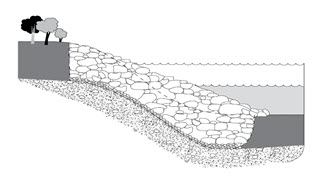
Fig. 12.4. Cross Section of a Riprap Revetment.
(Source: http://www.bae.ncsu.edu/programs/extension/wqg/sri/erosion5.PDF)
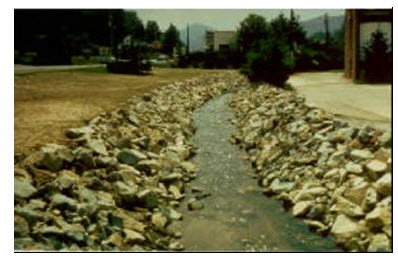
Fig. 12.5. Riprap for Protection of River Bank.
(Source: http://www.bae.ncsu.edu/programs/extension/wqg/sri/erosion5.PDF)
12.8.2 Gabions
Gabions are rectangular galvanized wire baskets filled with stones used as pervious, semi flexible building blocks for slope and channel stabilization (Fig. 12.6). Live rooting branches may be placed between the rock-filled baskets. Gabions are generally used where flow velocities are too high for riprap of small stones or the surface to be protected has a very steep slope.
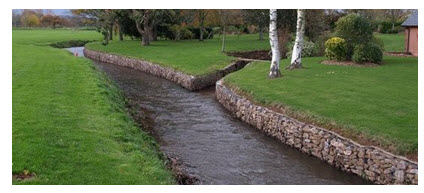
Fig. 12.6. Use of Gabions for Protecting the Stream Bank from Erosion. (Source: http://www.gabion1.com.au/gabion_erosion_control.htm)
12.8.3 Soil Bio-engineering Practices
Bio-engineering uses plant materials in a structural way to reinforce and stabilize eroding stream banks. This technique relies on the use of dormant cuttings of willows, shrub dogwoods and other plants that root easily (Fig. 12.7). Bio-engineering practices range from simple live stakes to complex structures such as fabricated lifts incorporating erosion control blankets, plants and compacted soil.

Fig. 12.7. Bio-engineering Practices to Stabilize Eroding Banks Native Material Revetments. (Source: http://www.sotir.com/index.html)
These practices use native materials, wood and stone to armor stream banks and deflect flow away from them. Low rock walls and log crib-walls can be used to armor the bank. Rootwads armor the bank and provide protection downstream by deflecting the flow away from the bank (Fig. 12.8). Rock and logs can be used to construct a variety of structures that stabilize the streambed and banks. Cross vanes are rock structures that stabilize the streambed while aiding in stream bank stabilization. Rock or log vanes redirect stream flow away from the toe of the stream bank and help to stabilize the bank upstream and downstream from the structure (Fig. 12.9).
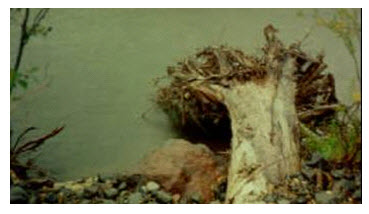
Fig. 12.8. Rootwads Armor to Protect the River Bank in-stream Structures. (Source: http://www.bae.ncsu.edu/programs/extension/wqg/sri/erosion5.PDF)

Fig. 12.9. Rock Vanes for Protection of Stream Bank. (Source: http://www.bae.ncsu.edu/programs/extension/wqg/sri/erosion5.PDF)
Keywords: Bank Erosion, Impacts, Control Measures, Stabilize Eroding Banks
References
Centre for Transportation Research and Education, Iowa State University, URL: http://www.ctre.iastate.edu/erosion/manuals/streambank/how_to_control.pdf; accessed on Dec 04, 2012.
Gabion1. URL: http://www.gabion1.com.au/gabion_erosion_control.htm
Government of Queensland, Australia, Natural Resources and Water, URL: http://www.derm.qld.gov.au/factsheets/pdf/river/r2.pdf; accessed on Dec 04, 2012.
Land Care Australia, Field Guide book, URL: http://www.landcare.net.au/files/fieldguidebook/sbank.html; accessed on Dec 04, 2012.
North Carolina State University, Stream notes, URL: http://www.bae.ncsu.edu/programs/extension/wqg/sri/erosion5.PDF; accessed on Dec 04, 2012.
Sotir & Associates. URL: http://www.sotir.com/index.html
The Encyclopedia of New Zealand. URL: www.teara.govt.nz; accessed on 29th September 2013.
Suggested Readings
Environmental and Water Resources Institute (U.S.) ASCE Task Committee (2008) Sedimentation Engineering: Processes, Measurements, Modeling, and Practice
Blanco-Canqui, H., Blanco, H., Lal, R., (2009) Principles of Soil Conservation and Management, Springer